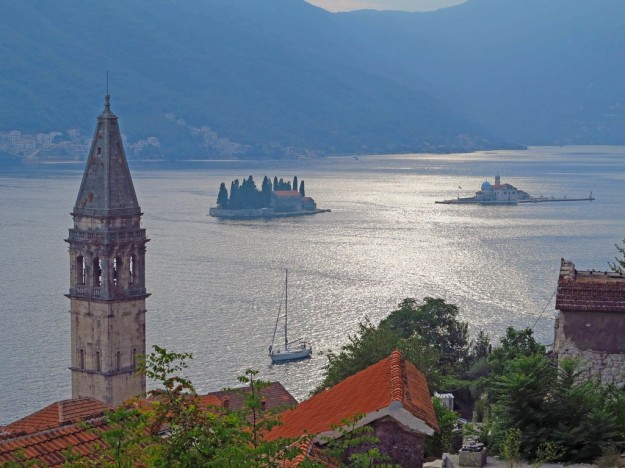MontenegroΜαυροβούνιο
Montenegro, in its present state, is a new country. After the separation of Yugoslavia, in 1991, it was part of Serbia. It was just in 2006 that it gained its independence. Entering into the country, we had a beautiful ride by the Skadar Lake. We arrived at Sveti Stefan, the iconic islet with its Old City, which a Greek ship-owner has rented for 45 years and has turned it into an upmarket hotel. Now, even the locals are not allowed to visit it, if they don’t get permission. They cannot even go to Sveti Stefan Church to pray. So it’s normal that they complain about it. Having been disgusted of the wealth and the show off we witnessed there, we went over Budva, to get a second dose of it all. At least, we were able to visit the Old City there.
What surprised us the most was the old capital of Montenegro, Cetinje. It’s a picturesque small town, spread up across a valley, with low houses, everyone having its own garden, built out of wood most of the times, and painted in vivid colours. The architecture of many public buildings is very similar to this of the Austrian ones, using as building material big, heavy stone blocks, and with beautiful roofs to embellish them. Cetinje is not that exciting but it has a nice atmosphere. We had this sense of being in a human city, where even I, that I don’t like cities, could live in. It was there where we felt for the first time that we were in Northern Europe, a feeling that followed us throughout every visit in the cities of Montenegro.
We made a lovely ride through the mountainous Lovćen National Park and, there, taking a turn on some dirt road, we found the perfect spot for camping, up on the altitude of 1,320 m. (4,331 ft.). If you pass by this area, don’t miss it, I have it marked on Live Trip Traveller. Riding down the mountain, we couldn’t get enough of the view of the Kotor Bay from above. It makes such a formation that it reminds you of a fjord. We made a stroll by the sea, and we even had a dip, which was our first one into the sea, as every dip we have had so far was in lakes and freezing cold rivers! The Old City of Kotor, inside the Venetian fortress, was what we enjoyed the most.

The picturesque Perast on the Bay of Kotor which, thanks to its formation, it can be easily mistaken for a Scandinavian fjord!
It was there when it started to rain, better say downpouring, which did not allow us to enjoy the places we visited. Usually, the rain would last a couple of hours, so either we would be in a city and we would find shelter in some temple or we would be on the road and we would simply put on our rain suits and keep going. It was this one day, though, that it was raining all night long, and continued to rain until 13:00, so we had to stay inside the tents for some hours.
After a small walk around the Old City of Herceg Novi, which is less touristy, we headed towards the most important pilgrimage site for the Orthodox Christians in Montenegro, Ostrog Monastery. It is built on the vertical side of a rock, making the most of the two small caves formed there.
At that point we started our rides on the mountains, for which I’ve waited for so long. From the Biogradska Gora National Park, we took a dirt road that was climbing up to 1,930 m. (6,332 ft.). The scenery was magnificent! It was there where John lost one of his motorcycle hand guards and he also broke the metal mounting of the protection bars he had made for the fairing. Using some wire, everything was put into place! We camped by a crystal-clear little stream and we fell asleep listening to the sound of the water, flowing peacefully through the lush small valley.
Riding through Tara Canyon, by the homonymous river, we entered Durmitor National Park. We visited the popular Black Lake and we took a fantastic little road to the border with Bosnia-Herzegovina. We passed through the mountain pass of Pašina Voda on 1,908 m. (6,260 ft.) and we kept moving on spectacular plateaus for quite a while. We spent our last day in Montenegro by the river of Piva.

Riding up on the mountain to 1,930 m. (6,332 ft.). Up on the ridge it was very windy and foggy. I didn’t really understand why John was not very willing to camp there 😛
This small country has lots of beauties for sure, but we were disappointed to find that everything has been overdeveloped for tourists, especially the coastline. Maybe Montenegro is too developed for my taste. The good thing is it’s developed in a logical way. You may have to pay for almost everything, like parking, using the public toilets, entering national parks etc. but the prices are reasonable and everything is well organized. Moreover, the locals show an incredible attitude. The drivers make way for motorcyclists to pass and they don’t drive aggressively. However, I really miss the epic off-road riding on the majestic mountains of Albania…
Here you can watch the video from our trip in Montenegro (with English subtitles):
Το Μαυροβούνιο στη σημερινή του μορφή είναι ένα νέο κράτος. Αφού διαλύθηκε η Γιουγκοσλαβία, το 1991, ήταν μέρος της Σερβίας. Μόλις το 2006 ανεξαρτητοποιήθηκε. Μπαίνοντας στη χώρα, κάναμε μια όμορφη διαδρομή δίπλα στη Λίμνη Skadar. Φτάσαμε μέχρι το Sveti Stefan, το πολυφωτογραφημένο νησάκι με την παλιά πόλη, την οποία ένας Έλληνας εφοπλιστής έχει νοικιάσει για 45 χρόνια και τη μετέτρεψε σε ξενοδοχείο. Τώρα ούτε οι ντόπιοι δε μπορούν να την επισκεφτούν, αν δεν έχουν άδεια από το ξενοδοχείο, οπότε λογικό είναι να έχουν παράπονα. Αφού αηδιάσαμε από τον πλούτο και τη φιγούρα που είδαμε εκεί, πήγαμε και στη Budva, για μια δεύτερη δόση. Τουλάχιστον εκεί μπορούσαμε να επισκεφτούμε την παλιά πόλη.
Η έκπληξη ήταν η παλιά πρωτεύουσα του Μαυροβουνίου, το Cetinje. Είναι μια συμπαθητική, μικρή πόλη απλωμένη σε μια κοιλάδα με χαμηλά σπίτια, που όλα έχουν τον κήπο τους. Συνήθως είναι ξύλινα κι έχουν ζωηρά χρώματα. Η αρχιτεκτονική αρκετών δημοσίων κτιρίων θυμίζει την αυστριακή, έχοντας χτιστεί με μεγάλες, βαριές πέτρες και με όμορφες στέγες να τα στολίζουν. Το Cetinje δεν έχει κάτι το συναρπαστικό, αλλά έχει μια ωραία ατμόσφαιρα. Νιώσαμε πως είναι ανθρώπινη πόλη, στην οποία θα μπορούσα να ζήσω ακόμη κι εγώ, που δε συμπαθώ τις πόλεις. Κάπου εκεί αρχίσαμε να νιώθουμε πως είμαστε στη Βόρεια Ευρώπη, πράγμα που δεν πάψαμε να το νιώθουμε στις πόλεις του Μαυροβουνίου.
Κάναμε μια ωραία διαδρομή στο ορεινό Εθνικό Πάρκο Lovćen και κάπου εκεί πήραμε ένα χωματόδρομο και βρήκαμε ένα καταπληκτικό μέρος για κατασκήνωση στα 1.320 μ. υψόμετρο. Για όσους περάσουν από ‘κει, έχω το στίγμα στο Live Trip Traveller. Κατεβαίνοντας από το βουνό, δε χορταίναμε να βλέπουμε από ψηλά τον Κόλπο του Kotor. H μορφή του είναι τέτοια, που θυμίζει φιόρδ. Κάναμε μια βόλτα δίπλα στη θάλασσα και ρίξαμε και μια βουτιά, που ήταν η πρώτη μας σε θάλασσα, γιατί όλες οι υπόλοιπες ήταν σε λίμνες και παγωμένα ποτάμια! Η παλιά πόλη του Kotor, μέσα στο βενετσιάνικο κάστρο, ήταν αυτή που μας άρεσε περισσότερο.

Το γραφικό Perast στον Κόλπο του Kotor, που με τη μορφή του δίνει την εντύπωση πως είναι σκανδιναβικό φιόρδ!
Κάπου εκεί άρχισαν οι βροχές, που συνήθως ήταν καταρρακτώδεις και δε μας επέτρεπαν να χαρούμε τα μέρη που επισκεπτόμασταν. Διαρκούσαν λίγες ώρες, οπότε αν ήμασταν σε καμιά πόλη, κρυβόμασταν σε κανένα ναό ή αν ήμασταν στο δρόμο, απλά φορούσαμε τ’ αδιάβροχα και συνεχίζαμε. Μια μέρα, όμως, έβρεχε από το βράδυ μέχρι τις 13:00 και μείναμε μέσα στ’ αντίσκηνα μέχρι να σταματήσει. Αυτά τα γράφω περισσότερο για να μη ζηλεύουν τα παλικάρια του moto! Ορίστε, σαπίσαμε κι εμείς απ’ τη βροχή!
Αφού περπατήσαμε λίγο και την παλιά πόλη του Herceg Novi, που είναι λιγότερο τουριστική, κατευθυνθήκαμε προς το σημαντικότερο τόπο προσκυνήματος του Μαυροβουνίου για τους Χριστιανούς Ορθόδοξους, το Μοναστήρι Ostrog. Είναι χτισμένο πάνω σ’ έναν κάθετο βράχο, αξιοποιώντας δυο μικρές σπηλιές που υπάρχουν εκεί.
Έκτοτε άρχισαν οι διαδρομές μας στα βουνά, που τόσο περίμενα. Από το Εθνικό Πάρκο Biogradska Gora πήραμε ένα χωματόδρομο, που ανέβαινε μέχρι τα 1.930 μ.. Το τοπίο ήταν πανέμορφο! Κάπου εκεί έπεσε η μια χούφτα από τη μοτοσυκλέτα του Γιάννη, ενώ του έσπασε η μεταλλική βάση από τις προστατευτικές μπάρες που έχει φτιάξει γύρω από το fairing. Με λίγο σύρμα διορθώθηκαν όλα! Κατασκηνώσαμε δίπλα σ’ ένα κρυστάλλινο, μικρό ρυάκι και κοιμηθήκαμε ακούγοντας το νερό να κυλά ήρεμα στο καταπράσινο λιβαδάκι.

Το πανέμορφο μέρος όπου κατασκηνώσαμε, στα 1.800 μ. υψόμετρο, ανάμεσα στα λικνίσματα του φιδίσιου ρυακιού.
Οδηγώντας μέσα στο Φαράγγι Tara και δίπλα στον ομώνυμο ποταμό, μπήκαμε στο Εθνικό Πάρκο Durmitor. Είδαμε τη δημοφιλή Μαύρη Λίμνη και πήραμε ένα καταπληκτικό δρομάκι προς τα σύνορα της Βοσνίας – Ερζεγοβίνης. Περάσαμε το ορεινό πάσο Pašina Voda στα 1.908 μ. και κινιόμασταν σε πανέμορφα οροπέδια για αρκετή ώρα. Την τελευταία μας μέρα στο Μαυροβούνιο την περάσαμε δίπλα στον ποταμό Piva.

Ανεβαίνοντας το βουνό μέχρι τα 1.930 μ. υψόμετρο. Στην κορυφογραμμή είχε δυνατό αέρα και πολύ ομίχλη. Δεν καταλαβαίνω γιατί ο Γιάννης δεν ήθελε να κατασκηνώσουμε εκεί :-Ρ
Αυτή η μικρή χώρα, σίγουρα έχει πολλές ομορφιές, αλλά μας εξέπληξε αρνητικά το γεγονός πως έχουν εκμεταλλευτεί τουριστικά τα πάντα και ειδικά τα παράλια. Παραείναι ανεπτυγμένο το Μαυροβούνιο για τα γούστα μας. Το θετικό είναι πως το έχουν αξιοποιήσει σωστά. Μπορεί να πρέπει να πληρώσει κανείς για το παραμικρό, όπως στάθμευση, τουαλέτες, εθνικά πάρκα κ.λ.π., αλλά οι τιμές είναι λογικές και τα πάντα είναι απίστευτα οργανωμένα. Επίσης, οι ντόπιοι είναι άριστοι στη συμπεριφορά τους. Οι οδηγοί πάντα μας άνοιγαν δρόμο για να περάσουμε και δεν οδηγούσαν επιθετικά. Μου έλειψαν, όμως, οι επικές εκτός δρόμου διαδρομές στα αγέρωχα βουνά της Αλβανίας…
Εδώ μπορείτε να δείτε και το σχετικό βίντεο από το ταξίδι μας στο Μαυροβούνιο:


















